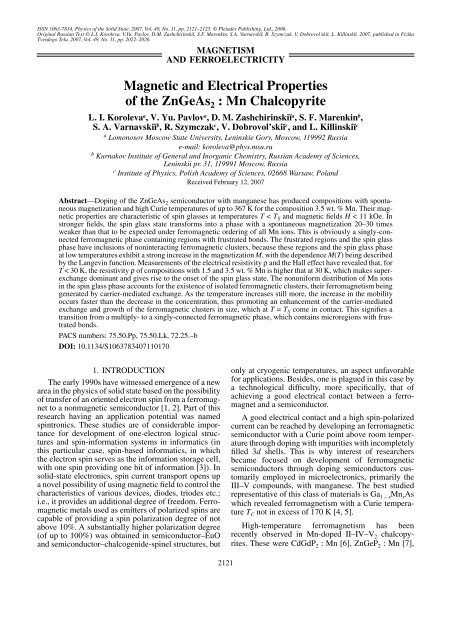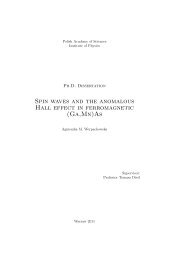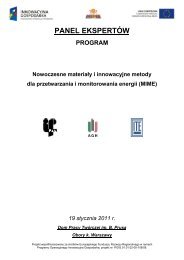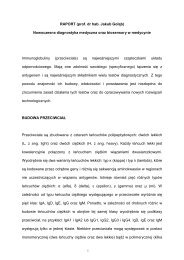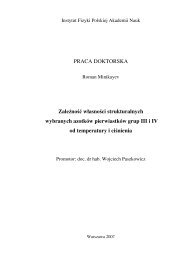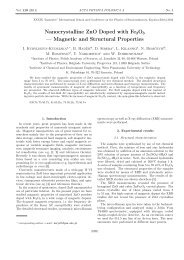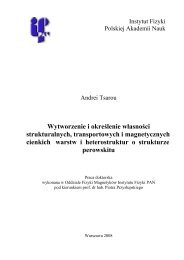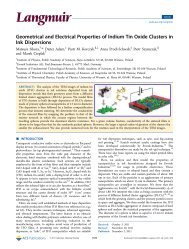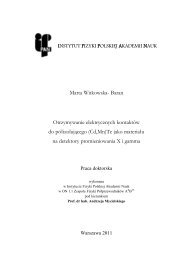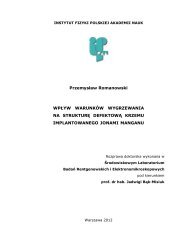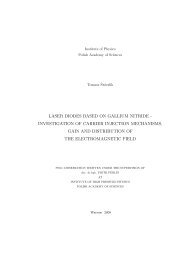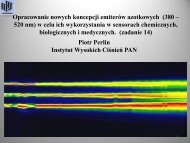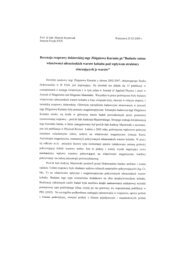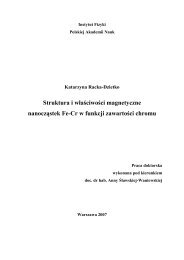Magnetic and Electrical Properties of the ZnGeAs2 : Mn Chalcopyrite
Magnetic and Electrical Properties of the ZnGeAs2 : Mn Chalcopyrite
Magnetic and Electrical Properties of the ZnGeAs2 : Mn Chalcopyrite
You also want an ePaper? Increase the reach of your titles
YUMPU automatically turns print PDFs into web optimized ePapers that Google loves.
ISSN 1063-7834, Physics <strong>of</strong> <strong>the</strong> Solid State, 2007, Vol. 49, No. 11, pp. 2121–2125. © Pleiades Publishing, Ltd., 2006.Original Russian Text © L.I. Koroleva, V.Yu. Pavlov, D.M. Zashchirinskiœ, S.F. Marenkin, S.A. Varnavskiœ, R. Szymczak, V. Dobrovol’skiœ, L. Killinskiœ, 2007, published in FizikaTverdogo Tela, 2007, Vol. 49, No. 11, pp. 2022–2026.MAGNETISMAND FERROELECTRICITY<strong>Magnetic</strong> <strong>and</strong> <strong>Electrical</strong> <strong>Properties</strong><strong>of</strong> <strong>the</strong> ZnGeAs 2 : <strong>Mn</strong> <strong>Chalcopyrite</strong>L. I. Koroleva a , V. Yu. Pavlov a , D. M. Zashchirinskiœ a , S. F. Marenkin b ,S. A. Varnavskiœ b , R. Szymczak c , V. Dobrovol’skiœ c , <strong>and</strong> L. Killinskiœ caLomonosov Moscow State University, Leninskie Gory, Moscow, 119992 Russiae-mail: koroleva@phys.msu.rubKurnakov Institute <strong>of</strong> General <strong>and</strong> Inorganic Chemistry, Russian Academy <strong>of</strong> Sciences,Leninskii pr. 31, 119991 Moscow, RussiacInstitute <strong>of</strong> Physics, Polish Academy <strong>of</strong> Sciences, 02668 Warsaw, Pol<strong>and</strong>Received February 12, 2007Abstract—Doping <strong>of</strong> <strong>the</strong> ZnGeAs 2 semiconductor with manganese has produced compositions with spontaneousmagnetization <strong>and</strong> high Curie temperatures <strong>of</strong> up to 367 K for <strong>the</strong> composition 3.5 wt. % <strong>Mn</strong>. Their magneticproperties are characteristic <strong>of</strong> spin glasses at temperatures T < T S <strong>and</strong> magnetic fields H < 11 kOe. Instronger fields, <strong>the</strong> spin glass state transforms into a phase with a spontaneous magnetization 20–30 timesweaker than that to be expected under ferromagnetic ordering <strong>of</strong> all <strong>Mn</strong> ions. This is obviously a singly-connectedferromagnetic phase containing regions with frustrated bonds. The frustrated regions <strong>and</strong> <strong>the</strong> spin glassphase have inclusions <strong>of</strong> noninteracting ferromagnetic clusters, because <strong>the</strong>se regions <strong>and</strong> <strong>the</strong> spin glass phaseat low temperatures exhibit a strong increase in <strong>the</strong> magnetization M, with <strong>the</strong> dependence M(T) being describedby <strong>the</strong> Langevin function. Measurements <strong>of</strong> <strong>the</strong> electrical resistivity ρ <strong>and</strong> <strong>the</strong> Hall effect have revealed that, forT < 30 K, <strong>the</strong> resistivity ρ <strong>of</strong> compositions with 1.5 <strong>and</strong> 3.5 wt. % <strong>Mn</strong> is higher that at 30 K, which makes superexchangedominant <strong>and</strong> gives rise to <strong>the</strong> onset <strong>of</strong> <strong>the</strong> spin glass state. The nonuniform distribution <strong>of</strong> <strong>Mn</strong> ionsin <strong>the</strong> spin glass phase accounts for <strong>the</strong> existence <strong>of</strong> isolated ferromagnetic clusters, <strong>the</strong>ir ferromagnetism beinggenerated by carrier-mediated exchange. As <strong>the</strong> temperature increases still more, <strong>the</strong> increase in <strong>the</strong> mobilityoccurs faster than <strong>the</strong> decrease in <strong>the</strong> concentration, thus promoting an enhancement <strong>of</strong> <strong>the</strong> carrier-mediatedexchange <strong>and</strong> growth <strong>of</strong> <strong>the</strong> ferromagnetic clusters in size, which at T = T S come in contact. This signifies atransition from a multiply- to a singly-connected ferromagnetic phase, which contains microregions with frustratedbonds.PACS numbers: 75.50.Pp, 75.50.Lk, 72.25.–bDOI: 10.1134/S10637834071101701. INTRODUCTIONThe early 1990s have witnessed emergence <strong>of</strong> a newarea in <strong>the</strong> physics <strong>of</strong> solid state based on <strong>the</strong> possibility<strong>of</strong> transfer <strong>of</strong> an oriented electron spin from a ferromagnetto a nonmagnetic semiconductor [1, 2]. Part <strong>of</strong> thisresearch having an application potential was namedspintronics. These studies are <strong>of</strong> considerable importancefor development <strong>of</strong> one-electron logical structures<strong>and</strong> spin-information systems in informatics (inthis particular case, spin-based informatics, in which<strong>the</strong> electron spin serves as <strong>the</strong> information storage cell,with one spin providing one bit <strong>of</strong> information [3]). Insolid-state electronics, spin current transport opens upa novel possibility <strong>of</strong> using magnetic field to control <strong>the</strong>characteristics <strong>of</strong> various devices, diodes, triodes etc.;i.e., it provides an additional degree <strong>of</strong> freedom. Ferromagneticmetals used as emitters <strong>of</strong> polarized spins arecapable <strong>of</strong> providing a spin polarization degree <strong>of</strong> notabove 10%. A substantially higher polarization degree(<strong>of</strong> up to 100%) was obtained in semiconductor–EuO<strong>and</strong> semiconductor–chalcogenide-spinel structures, butonly at cryogenic temperatures, an aspect unfavorablefor applications. Besides, one is plagued in this case bya technological difficulty, more specifically, that <strong>of</strong>achieving a good electrical contact between a ferromagnet<strong>and</strong> a semiconductor.A good electrical contact <strong>and</strong> a high spin-polarizedcurrent can be reached by developing an ferromagneticsemiconductor with a Curie point above room temperaturethrough doping with impurities with incompletelyfilled 3d shells. This is why interest <strong>of</strong> researchersbecame focused on development <strong>of</strong> ferromagneticsemiconductors through doping semiconductors customarilyemployed in microelectronics, primarily <strong>the</strong>III–V compounds, with manganese. The best studiedrepresentative <strong>of</strong> this class <strong>of</strong> materials is Ga 1 – x <strong>Mn</strong> x Aswhich revealed ferromagnetism with a Curie temperatureT C not in excess <strong>of</strong> 170 K [4, 5].High-temperature ferromagnetism has beenrecently observed in <strong>Mn</strong>-doped II–IV–V 2 chalcopyrites.These were CdGdP 2 : <strong>Mn</strong> [6], ZnGeP 2 : <strong>Mn</strong> [7],2121
2122KOROLEVA et al.M, emu/g43210M, emu/g1.00.80.60.40.2H = 600 OeZFCFCH = 50 Oe0 50 150 250 350T, K100 200 300 400T, KFig. 1. Temperature dependence <strong>of</strong> <strong>the</strong> magnetization M for<strong>the</strong> composition ZnGeAs 2 with 3.5 wt. % <strong>Mn</strong> in magneticfields <strong>of</strong> 50 kOe <strong>and</strong> 0.6 kOe (inset). The ZFC curve: <strong>the</strong>sample was zero-field-cooled from 400 to 5 K, after whichits magnetization was measured under heating. The FCcurve: <strong>the</strong> sample was cooled in a field <strong>of</strong> 0.6 kOe from 400to 5 K with parallel measurement <strong>of</strong> its magnetization.<strong>and</strong> ZnSnAs 2 : <strong>Mn</strong> [8], compounds with <strong>the</strong> Curie pointas high as 350 K. We reported on <strong>the</strong> compoundCdGeAs 2 : <strong>Mn</strong>, whose Curie temperature T C was stillhigher, 355 K.The II–IV–V 2 ternary semiconductors have beenknown for a long time. These compounds are crystallochemical<strong>and</strong> electronic analogs <strong>of</strong> <strong>the</strong> III–V semiconductors.Interest in <strong>the</strong>se compounds emerged afterone discovered <strong>the</strong>ir unique nonlinear optical properties,namely, <strong>the</strong> high nonlinear polarizability <strong>and</strong> birefringence,which opened a way to <strong>the</strong>ir use for parametricconversion <strong>of</strong> laser radiation in <strong>the</strong> mid-IR range.The most promising for this purpose are high-purityCdGeP 2 , CdGeAs 2 , <strong>and</strong> ZnGeP 2 crystals. The II–IV–V 2 -type compounds retain <strong>the</strong> main features characteristic<strong>of</strong> <strong>the</strong> III-V materials, namely, <strong>the</strong> predominantlycovalent bonding, small effective carrier masses, relativelyhigh mobilities <strong>of</strong> <strong>the</strong> electrons <strong>and</strong> holes, <strong>and</strong>persistence <strong>of</strong> <strong>the</strong> absolute minima <strong>and</strong> maxima <strong>of</strong> <strong>the</strong>conduction <strong>and</strong> <strong>the</strong> valence b<strong>and</strong> at Brillouin zone center.We prepared <strong>and</strong> studied new ZnGeAs 2 : <strong>Mn</strong> compoundswith <strong>the</strong> Curie point reaching 367 K, a recordhighvalue for II–IV–V 2 -type compounds. TheZnGeAs 2 compound studied in <strong>the</strong> present work possesses<strong>the</strong> following characteristics: b<strong>and</strong>gap 0.85 eV;mobility ~10 2 cm 2 /V s (for holes with concentrations <strong>of</strong>10 18 –5 × 10 19 cm –3 ); effective hole mass 0.4–0.74. Thismakes <strong>the</strong> II–IV–V 2 : <strong>Mn</strong> compounds promising forspintronics applications.2. EXPERIMENTAL TECHNIQUEWe report here on a study <strong>of</strong> <strong>the</strong> magnetization,electrical resistivity ρ, magnetoresistance ∆ρ/ρ = (ρ H –ρ H = 0 )/ρ H = 0 <strong>and</strong> <strong>the</strong> Hall effect <strong>of</strong> polycrystallineZnGeAs 2 : <strong>Mn</strong> samples with <strong>Mn</strong> contents <strong>of</strong> 1.5 to3.5 wt. %. The magnetization was measured with aSQUID magnetometer. The four-probe technique wasemployed to measure ρ <strong>and</strong> ∆ρ/ρ. The Hall effect wasstudied by <strong>the</strong> st<strong>and</strong>ard dc method. The contacts to <strong>the</strong>samples were secured with current-conducting glue.3. EXPERIMENTAL RESULTSAND DISCUSSIONThe ZnGeAs 2 samples were prepared by directalloying <strong>of</strong> high-purity powders <strong>of</strong> ZnAs 2 <strong>and</strong> Ge takenin stoichiometric ratio. <strong>Mn</strong> was introduced according to<strong>the</strong> hypo<strong>the</strong>tical ZnGeAs 2 –<strong>Mn</strong>GeAs 2 cut. To increase<strong>the</strong> <strong>Mn</strong> solubility, <strong>the</strong> rate <strong>of</strong> cooling from 900°C waschosen not lower than 5–10 K/s. X-ray diffraction analysisshowed all samples with <strong>the</strong> <strong>Mn</strong> contents <strong>of</strong> 1.5, 3,<strong>and</strong> 3.5 wt. % to be single phase, thus identifying <strong>the</strong>mas ZnGeAs 2 . A comparison <strong>of</strong> <strong>the</strong> lattice constantsrevealed that <strong>the</strong> cell volume decreases with increasing<strong>Mn</strong> content, which suggests formation <strong>of</strong> solid solutionsthrough <strong>Mn</strong> substitution for Zn. The contents <strong>of</strong><strong>the</strong> components were checked by x-ray fluorescence. Astudy <strong>of</strong> <strong>the</strong> distribution <strong>of</strong> elements over <strong>the</strong> samplelength showed that Zn : Ge : As = 1 : 1 : 2. Within experimentalerror, <strong>the</strong> <strong>Mn</strong> was found to be distributed uniformlyover <strong>the</strong> sample length.Figure 1 displays temperature dependence <strong>of</strong> <strong>the</strong>magnetization, M(T), for <strong>the</strong> composition with 3.5 wt.% <strong>Mn</strong> in a magnetic field H = 50 kOe. The M(T) curveobtained for T > 60 K is seen to be characteristic <strong>of</strong> aferromagnet. For T < 60 K, however, magnetization isobserved to grow strongly with decreasing temperature,an effect that can be interpreted as an additional contributiondue to <strong>the</strong> superparamagnetic phase. The inset toFig. 1 shows <strong>the</strong> M(T) plot measured in a weak magneticfield <strong>of</strong> 600 Oe. The M(T) curves obtained in astrong (50 kOe) <strong>and</strong> a weak (0.6 kOe) field are immediatelyseen to differ substantially. When measuring in<strong>the</strong> weak field, <strong>the</strong> magnetization is observed to dropstrongly as <strong>the</strong> temperature falls below T S = 86 K, withM decreasing 4.5 times. At T k = 10 K, this drop stops,<strong>and</strong> here one sees a difference between <strong>the</strong> magnetizations<strong>of</strong> <strong>the</strong> sample cooled from T > T C in this weakmagnetic field (FC curve) <strong>and</strong> <strong>the</strong> one that was zer<strong>of</strong>ieldcooled (ZFC curve) The FC curve exhibits a risewith fur<strong>the</strong>r decrease in <strong>the</strong> temperature. Shown inFig. 2 are M(T) curves in <strong>the</strong> temperature intervalincluding T S , which were measured in magnetic fields<strong>of</strong> 3, 6, 8, 9, <strong>and</strong> 11 kOe. Examining this figure showsthat as H increases, <strong>the</strong> decrease in <strong>the</strong> magnetization atT = T S becomes weaker to disappear altoge<strong>the</strong>r at11 kOe, <strong>and</strong> <strong>the</strong> value <strong>of</strong> T S shifts toward lower temper-PHYSICS OF THE SOLID STATE Vol. 49 No. 11 2007
MAGNETIC AND ELECTRICAL PROPERTIES 21232.52.0H = 11 kOe986M, emu/g0.10M, emu/g1.53–0.1ZFCFCZFC–0.2 00.2H, kOe1.00 40 80 120T, KFig. 2. Temperature dependence <strong>of</strong> <strong>the</strong> magnetization M for<strong>the</strong> composition ZnGeAs 2 with 3.5 wt. % <strong>Mn</strong> in differentmagnetic fields in <strong>the</strong> temperature range from 5 to 100 K.Each curve was measured after <strong>the</strong> sample had been cooledto 5 K with no magnetic field.atures. Indeed, as <strong>the</strong> field increases from 600 Oe to9 kOe, T S decreases from 86 to 49 K. This is paralleledby <strong>the</strong> rise in <strong>the</strong> M(T) curves observed to occur for T
2124KOROLEVA et al.41431212M, emu/g21T = 5 K25 K50 Kρ · 10 2 , Ω cm1081110R h · 10 2 , cm 3 /C0 10 20 30 40 50H, kOeFig. 4. Magnetization iso<strong>the</strong>rms <strong>of</strong> <strong>the</strong> ZnGeAs 2 samplewith 3.5 wt. % <strong>Mn</strong> at different temperatures. Each curvewas measured after <strong>the</strong> sample had been cooled to 5 K in azero magnetic field.60 50 100150 200 250 300T, K9Fig. 5. Temperature dependence <strong>of</strong> <strong>the</strong> electrical resistivityρ <strong>and</strong> <strong>the</strong> normal Hall coefficient R H for <strong>the</strong> ZnGeAs 2 samplewith 1.5 wt. % <strong>Mn</strong>.romagnetic phase depends on its configuration, whichvaries with temperature. Therefore, for <strong>the</strong> Curie pointwas taken <strong>the</strong> temperature obtained by extrapolation <strong>of</strong><strong>the</strong> steepest part <strong>of</strong> <strong>the</strong> M(T) curve measured in <strong>the</strong>maximum field reachable (50 kOe) to its intercept with<strong>the</strong> temperature axis. The Curie temperature was foundto be 367 K. This is <strong>the</strong> highest Curie temperaturefound thus far in <strong>the</strong> II–IV–V 2 : <strong>Mn</strong> systems. This providedsubstantiation for <strong>the</strong> <strong>the</strong>oretical suggestion [10]that <strong>the</strong> Curie temperatures <strong>of</strong> Zn-containing chalcopyritesshould be higher than those <strong>of</strong> <strong>the</strong> correspondingCd-based ones.The Hall electric field <strong>of</strong> <strong>the</strong> samples under studywas found to depend linearly on magnetic field, whichevidences <strong>the</strong> absence <strong>of</strong> anomalous Hall effect. Measurements<strong>of</strong> <strong>the</strong> electrical resistivity <strong>and</strong> <strong>of</strong> <strong>the</strong> Halleffect revealed that all <strong>the</strong> samples support hole conduction,with <strong>the</strong> hole concentration p ~ 10 19 –10 20 cm –3<strong>and</strong> mobility varying from 0.25 to 2.5 cm 2 V –1 s –1 . Figures5 <strong>and</strong> 6 plot <strong>the</strong> temperature dependences <strong>of</strong> <strong>the</strong>electrical resistivity ρ, normal Hall coefficient R H <strong>and</strong>mobility. We readily see that <strong>the</strong> ρ(T) relation <strong>of</strong> <strong>the</strong>1.5 wt. % <strong>Mn</strong> composition follows a pattern characteristic<strong>of</strong> semiconductors, while <strong>the</strong> p(T) curve has apurely metallic signature, with p varying very little,from 6.4 × 10 19 cm –3 at T = 50 K to 5.2 × 10 19 cm –3 at300 K. The mobility grows faster, from 1.25 cm 2 V –1 s –1 at20 K to 2.6 cm 2 V –1 s –1 at 300 K. In <strong>the</strong> 3.5 wt. % <strong>Mn</strong>composition, ρ(T) passes through a minimum at T ~30 K, <strong>and</strong> <strong>the</strong> mobility increases by an order <strong>of</strong> magnitudein <strong>the</strong> region 10 ≤ T ≤ 300 K, whereas p varies from2.5 × 10 20 cm –3 at 50 K to 8 × 10 19 cm –3 at 300 K. Themagnetoresistance is small; it does not exceed 4% atH = 8 kOe.The origin <strong>of</strong> ferromagnetism in dilute magneticsemiconductors was studied by first-principles electronicstructure calculations [11, 12]. It is maintained[11, 12] that <strong>the</strong> effective exchange interaction in <strong>the</strong>secompounds derives primarily from competitionbetween double exchange <strong>and</strong> superexchange interactions.It is known that semiconductors with chalcopyritestructure are stabilized by internal defects acting assources <strong>of</strong> holes which form stable complexes with <strong>Mn</strong>ρ · 10 3 , Ω cm34302622180 50 1003.53.02.52.01.51.00.50150 200 250 300T, KFig. 6. Temperature dependence <strong>of</strong> <strong>the</strong> electrical resistivityρ <strong>and</strong> <strong>the</strong> hole mobility for <strong>the</strong> ZnGeAs 2 sample with3.5 wt. % <strong>Mn</strong>.µ, cm 2 /V sPHYSICS OF THE SOLID STATE Vol. 49 No. 11 2007
MAGNETIC AND ELECTRICAL PROPERTIES 2125[13]. It should be pointed out that double exchangeinvolves carrier transfer among ions residing in differentvalence states, in this particular case, between <strong>Mn</strong> 2+<strong>and</strong> <strong>Mn</strong> 3+ . As shown earlier, in <strong>the</strong> system under study<strong>Mn</strong> substitutes for Zn, so that <strong>the</strong> above complexes areactually (Zn, V C , <strong>Mn</strong>), where V C are vacancies. It is notknown, however, how vacancies affect <strong>the</strong> distribution<strong>of</strong> <strong>the</strong> <strong>Mn</strong> 2+ <strong>and</strong> <strong>Mn</strong> 3+ ions. Therefore we are going toreplace subsequently <strong>the</strong> term “double exchange” witha broader concept <strong>of</strong> “carrier-mediated exchange”. Asseen from Figs. 5 <strong>and</strong> 6, for T < 30 K, <strong>the</strong> electricalresistivity <strong>of</strong> <strong>the</strong> compositions with 1.5 <strong>and</strong> 3.5 wt. %<strong>Mn</strong> is higher than that at 30 K, a factor that apparentlyaccounts for <strong>the</strong> superexchange becoming dominant.As shown in [14], spin glass is <strong>the</strong> ground state in thiscase. As <strong>the</strong> temperature increases, mobility increaseswith a rate faster than that <strong>of</strong> <strong>the</strong> small concentrationdrop, thus favoring carrier-mediated exchange, whichinitiates <strong>the</strong> transition from <strong>the</strong> spin glass to <strong>the</strong> ferromagneticstate. One could suggest also ano<strong>the</strong>r scenariobased on <strong>the</strong> energies <strong>of</strong> superexchange <strong>and</strong> carriermediatedexchange being close, which is not in conflictwith <strong>the</strong> observed magnetic <strong>and</strong> transport properties.Because <strong>the</strong> <strong>Mn</strong> ions dissolving in ZnGeAs 2 becomer<strong>and</strong>omly distributed, one may conceive formation atlow temperatures in <strong>the</strong> spin glass matrix <strong>of</strong> ferromagneticclusters, whose ferromagnetism rests upon <strong>the</strong>higher carrier-mediated exchange energy. As <strong>the</strong> temperatureincreases, <strong>the</strong>se clusters grow in volume due to<strong>the</strong> increasing hole mobility, until at a certain temperature<strong>the</strong>se clusters come in contact. This signals <strong>the</strong>transition from a multiply connected ferromagneticphase made up <strong>of</strong> isolated ferromagnetic clusters to <strong>the</strong>singly connected ferromagnetic phase, within whichmicroregions with frustrated bonds are embedded.REFERENCES1. H. Ohno, Science (Washington) 281, 951 (1998).2. G. A. Prinz, Science (Washington) 282, 1660 (1998).3. F. Matsukura, H. Ohno, A. Shen, <strong>and</strong> Y. Sugawara, Phys.Rev. B: Condens. Matter 57, R2037 (1998).4. K. M. Edmonds, K. Y. Wang, R. P. Campion, A. C. Neumann,N. R. S. Farley, B. L. Gallagher, <strong>and</strong> C. T. Foxon,Appl. Phys. Lett. 81, 4991 (2002).5. K. M. Edmonds, P. Boguslawski, K. Y. Wang, R. P. Campion,S. N. Novikov, N. R. S. Farley, B. L. Gallagher,C. T. Foxon, M. Sawicki, T. Dietl, M. BuongiornoNardelli, <strong>and</strong> J. Bernholc, Phys. Rev. Lett. 92, 03720(2004).6. G. A. Medvedkin, T. Ishibashi, T. Nishi, K. Hayata,Y. Hasegawa, <strong>and</strong> K. Sato, Jpn. J. Appl. Phys. 39, L949(2000).7. G. A. Medvedkin, K. Hirose, T. Ishibashi, T. Nishi,V. G. Voevodin, <strong>and</strong> K. Sato, J. Cryst. Growth 236, 609(2002).8. S. Choi, G.-B. Cha, S. C. Hong, S. Cho, Y. Kim,J. B. Ketterson, S.-Y. Jeong, <strong>and</strong> G.-C. Yi, Solid StateCommun. 122, 165 (2002).9. R. V. Demin, L. I. Koroleva, S. F. Marenkin, S. G. Mikhaœlov,V. M. Novotortsev, V. T. Kalinnikov, T. G. Aminov,R. Szymczak, G. Szymczak, <strong>and</strong> M. Baran, Pis’maZh. Tekh. Fiz. 30 (21), 81 (2004) [Tech. Phys. Lett. 30(11), 924 (2004)].10. P. R. Kent <strong>and</strong> T. C. Schul<strong>the</strong>ss, in Proceedings <strong>of</strong> <strong>the</strong>27th International Conference on Physics <strong>of</strong> Semiconductors(ICPS-27), Flagstaff, AZ, 2005, Ed. by J. Menendez<strong>and</strong> Ch. G. van de Walle (Flagstaff, 2005),p. 1369.11. H. Akai, Phys. Rev. Lett. 81, 3002 (1998).12. H. Akai, T. Kamatani, <strong>and</strong> S. Watanabe, J. Phys. Soc.Jpn. 69 (Suppl. A), 112 (2000).13. P. Mahadevan <strong>and</strong> A. Zunger, Phys. Rev. Lett. 88,047205 (2002).14. Y.-J. Zhao, W. T. Geng, A. J. Freeman, <strong>and</strong> T. Oguchi,Phys. Rev. B: Condens. Matter 63, R201202, (2001).Translated by G. SkrebtsovSPELL: OKPHYSICS OF THE SOLID STATE Vol. 49 No. 11 2007


